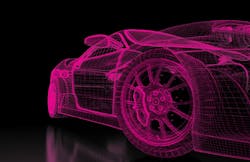This Week's Top Advanced Vehicle Design News
June 23, 2021—Automotive grade is a concept that is easy to understand but difficult to define in simple terms.
In an evolving world of automated vehicles and increasingly more technically sophisticated cars, the necessity of having a part, system or other component work as it is intended to has never been more important.
In a webinar from Partners for Automated Vehicle Education, experts from across the supply chain say they see automotive grade as quality, reliability and toughness throughout the manufacturing process, and they spoke about how important maintaining that high standard is when implementing new innovations, such as AVs, to the industry.
“Automotive grade, in its simplest terms … is built tough. We have to design not just the sensors but the whole system to almost work in the worst case,” says Derek Caveney, executive engineer for Toyota North America. “We have to consider it being operated in Alaska or the Arizona desert. We have to provide, to our customers, a system that is reliable and robust.”
Quality Through and Through
The high standard automotive grade suggests is nothing new. Any time a person gets into their vehicle, there are certain systems that they expect to function properly.
"There’s different levels of quality and reliability that you expect when you get into a vehicle. If you turn the wheel, your tires better turn. There are certain levels of risk assessment or hazard analysis that need to be performed at the lowest levels that ultimately influence the highest levels.”
Every component in a vehicle has to work properly every time it is turned on, whether it’s leaving the lot for the first time or is well into its second decade on the road. Caveney says Toyota and other OEMs must optimize their vehicles to be able to handle the worst conditions imaginable because customers are trusting their lives with that vehicle.
Even safety functions that no driver hopes to use must be guaranteed to work. Dr. Gunnar Juergens, VP and Head of LiDAR for Continental, says those systems have to be ready whenever they’re needed, even if it might take a decade or two for that time to arise.
“You never want to see it in action, but you buy it because you know it is there and you know it will work when you need it. It will sleep for 10 to 15 years, and if it comes to work, the lifetime is only 200 milliseconds,” he says. “Then the product is broken, but within this 200 milliseconds, nothing can go wrong. That is automotive grade.”
